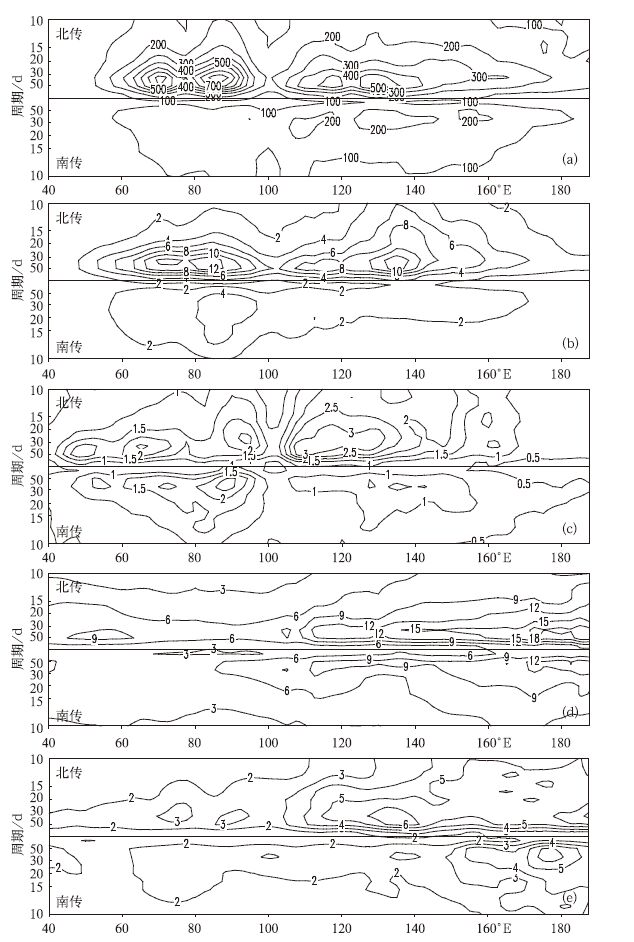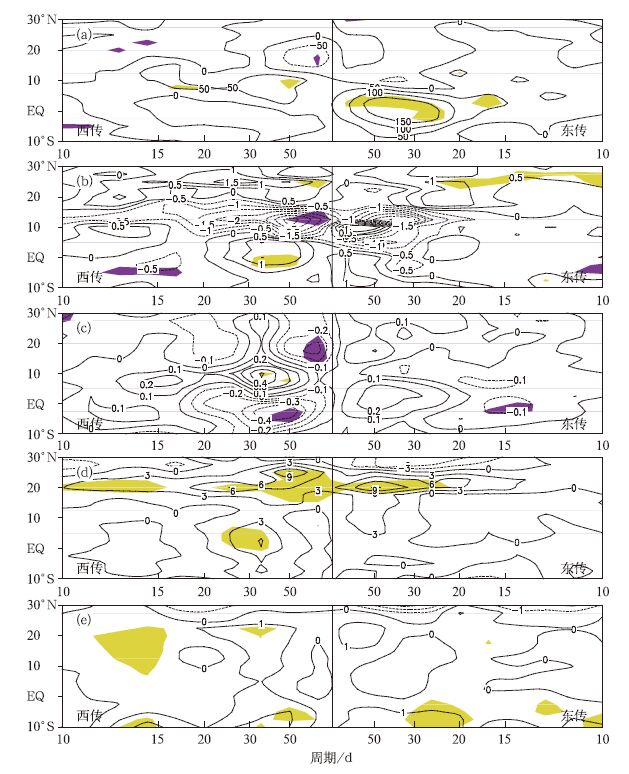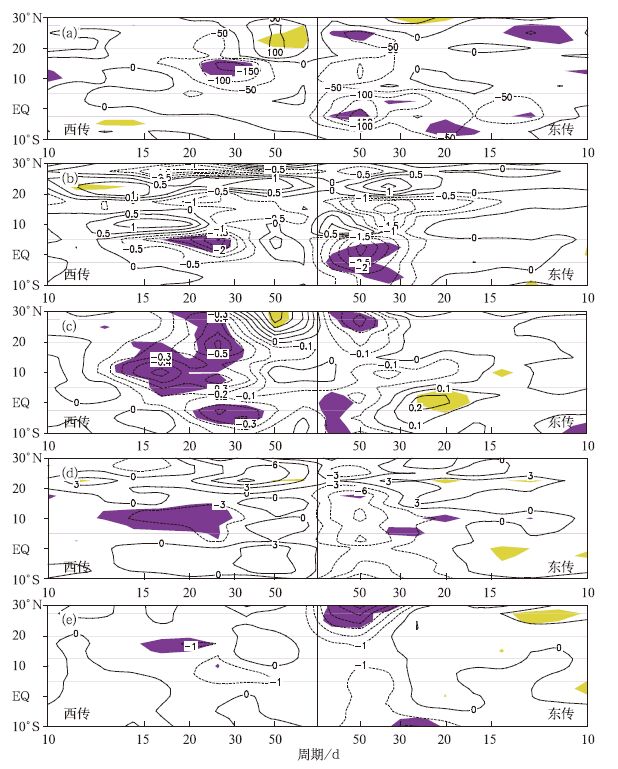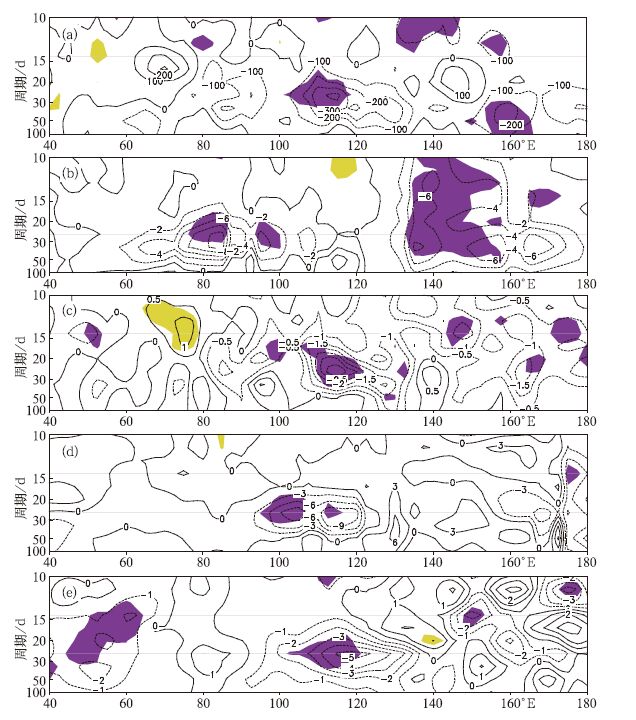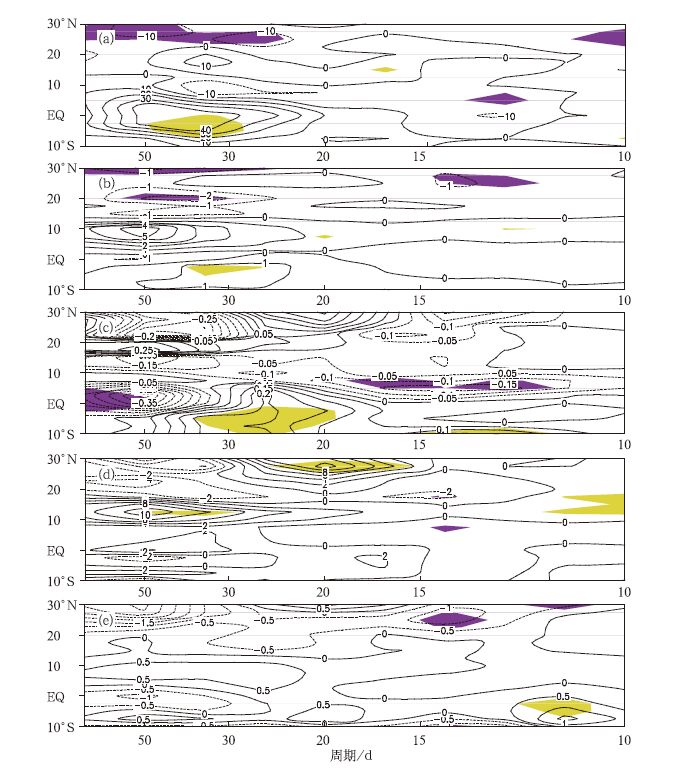热带夏季风场与对流场季节内振荡传播模比较
Comparison of Propagating Boreal Summer Intraseasonal Oscillation over Tropics Represented by Wind and Convection Fields
-
摘要: 利用1979—2007年卫星观测日平均OLR资料以及NCEP/DOE第2套再分析资料中的风场资料,采用有限区域波频分析、合成分析等方法,分析对比对流层高、低层风场与对流场所表征的热带北半球夏季季节内振荡(BSISO)各种传播模态谱分布气候特征及其年际异常。结果表明:各要素反映的BSISO各种模态的气候特征及其年际变化存在一定差异,总体而言对流层低层风(850 hPa纬向风或经向风)与对流比较一致。850 hPa经向风(纬向风)所反映的纬向(经向)传播BSISO谱分布气候特征与对流情况最相似。在ENSO发展年,850 hPa经向风反映的赤道东传波加强趋势与对流较为一致;850 hPa纬向风、经向风反映的北传波变化趋势都与对流相似。在ENSO衰减年,850 hPa纬向风(经向风)反映的赤道东传波(赤道外西传波)减弱趋势与对流较为一致;对流以及850 hPa经向风、200 hPa纬向风和200 hPa经向风4种要素都能体现南海及周边地区北传波明显减弱这一特征。对流和850 hPa纬向风所反映的北传波与印度洋偶极子模态之间关系一致。
-
关键词:
- 热带北半球夏季季节内振荡(BSISO);
- 各种传播模态;
- 气候特征及年际异常;
- 风场与对流场
Abstract: Finite-domain wavenumber-frequency analysis and components analysis are applied to analyze the spectrum climatology and inter annual anomaly of diversified propagating boreal summer intra-seasonal oscillation (BSISO) over tropics denoted by tropospheric wind field and convection field, based on the daily outgoing longwave radiation (OLR) data and the second set reanalysis data of NCEP/DOE (daily mean is obtained from 4 times observation). It shows that differences of BSISO climatology and inter-annual anomaly characteristics exist among different elements. Low level wind (850 hPa zonal wind or meridional wind) is more consistent with convection generally. Zonal (Meridional) propagating BSISO climatology characteristics denoted by 850 hPa meridional (zonal) wind is the most similar to those of convection. During the ENSO developing year, the enhanced tendency of eastward propagating mode at the equator reflected by 850 hPa meridional wind is more consistent with convection; the changing tendency of northward propagating mode reflected by both of 850 hPa meridional wind and zonal wind is similar to convection. The weakened tendency of northward propagating mode over eastern Indian Ocean reflected by 850 hPa zonal wind is more significant. During the ENSO decaying year, the weakened tendency of eastward (westward) propagating mode at the equator (off the equator) reflected by 850 hPa zonal (meridional) wind is more consistent with convection; 4 elements (convection, 850 hPa meridional wind, 200 hPa zonal wind and 200 hPa meridional wind) can exhibit the characteristic that the northward propagation over South China Sea and its border is suppressed, i.e., this characteristic is resulted from the combination of atmospheric anomaly between upper and low troposphere. The relationship between eastward propagation of BSISO at the equator and BWA mode of Indian Ocean is only presented by convection, and the other 4 elements of wind filed cannot reflect it. Both of convection and 850 hPa zonal wind can reflect the relationship between northward propagation and the Indian Ocean dipole mode. The northward propagation of BSISO over middle and eastern Indian Ocean and South China Sea weakened (enhanced) under positive (negative) dipole mode. The conclusions above indicate that different results would be obtained from different meteorological elements. This is one of the possible causes that the results are not consistent in the past. For different conditions, proper element should be selected for analyzing tropical BSISO. For example, from the view of the forecasting of regional weather and climate, element which indicates the forecasting area well can be chosen based on diagnoses of the remote relationship between weather in forecasting region and the activity of tropical BSISO. -
图 1 夏季 (5—10月) 西传模态与东传模态纬向一波 (40°E 180°) 谱分布
(a) OLR, (b) 850 hPa纬向风, (c) 850 hPa经向风, (d) 200 hPa纬向风, (e) 200 hPa经向风
Fig. 1 Westward and eastward propagating BSISO spectrum during boreal summer (May—October) for zonal wavenumber-1 (40°E—180°)
(a) OLR, (b) 850 hPa zonal wind, (c) 850 hPa meridionalwind, (d) 200 hPa zonal wind, (e) 200 hPa meridionalwind
图 2 夏季 (5—10月) 北传模态与南传模态经向一波 (5°S 25°N) 谱分布
(a) OLR, (b) 850 hPa纬向风, (c) 850 hPa经向风, (d) 200 hPa纬向风, (e) 200 hPa经向风
Fig. 2 Northward and southward propagating BSISO spectrum during boreal summer (May—October) for meridional wavenumber-1 (5°S—25°N)
(a) OLR, (b) 850 hPa zonal wind, (c) 850 hPa meridionalwind, (d) 200 hPa zonal wind, (e) 200 hPa meridionalwind
图 3 夏季 (5—10月) 纬向一波西传波与东传波功率谱在El Niña发展年与La Niña发展年之差值 (阴影区表示通过0.05显著性检验)
(a) OLR, (b) 850 hPa纬向风, (c) 850 hPa经向风, (d) 200 hPa纬向风, (e) 200 hPa经向风
Fig. 3 Energy spectrum difference of the zonal wavenumber-1 westward and eastward propagating BSISO between El Niña developing summer (May—October) and La Niña developing summer (the shaded area denotes passing the test of 0.05 level)
(a) OLR, (b) 850 hPa zonal wind, (c) 850 hPa meridional wind, (d) 200 hPa zonal wind, (e) 200 hPa meridional wind
图 4 夏季 (5—10月) 经向一波北传波功率谱在El Niña发展年与La Niñna发展年之差值 (阴影区表示通过0.05显著性检验)
(a) OLR, (b) 850 hPa纬向风, (c) 850 hPa经向风, (d) 200 hPa纬向风, (e) 200 hPa经向风
Fig. 4 4 Energy spectrum difference of the meridional wavenumber-1 northward propagating BSISO between El Niña developing summer (May—October) and La Niñna developing summer (the shaded area denotes passing the test of 0.05 level)
(a) OLR, (b) 850 hPa zonal wind, (c) 850 hPa meridional wind, (d) 200 hPa zonal wind, (e) 200 hPa meridional wind
图 5 夏季 (5—10月) 纬向一波西传波与东传波功率谱在El Niña衰减年与La Niñna衰减年之差值 (阴影区表示通过0.05显著性检验)
(a) OLR, (b) 850 hPa纬向风, (c) 850 hPa经向风, (d) 200 hPa纬向风, (e) 200 hPa经向风
Fig. 5 Energy spectrum difference of the zonal wavenumber-1 westward and eastward propagating BSISO between El Niña decaying summer (May—October) and La Niñna decaying summer (the shade darea denotes passing the test of 0.05 level)
(a) OLR, (b)850 hPa zonalwind, (c) 850 hPa meridionalwind, (d) 200 hPa zonalwind, (e) 200 hPa meridionalwind
图 6 夏季 (5—10月) 经向一波北传波功率谱在El Niño衰减年与LaNiñna衰减年之差值 (阴影区表示通过0.05显著性检验)
(a) OLR, (b) 850 hPa纬向风, (c) 850 hPa经向风, (d) 200 hPa纬向风, (e) 200 hPa经向风
Fig. 6 Energy spectrum difference of the meridional wavenumber-1 northward propagating BSISO between ElNiño decaying summer (May—October) and La Niñna decaying summer (the shaded area denotespassing the test of 0.05 level)
(a) OLR, (b)850 hPa zonalwind, (c) 850 hPa meridionalwind, (d) 200 hPa zonalwind, (e) 200 hPa meridionalwind
图 7 夏季 (5—10月) 纬向一波东传BSISO谱正BWA年与负BWA年之差 (阴影区为通过0.05显著性检验)(a) OLR, (b) 850 hPa纬向风, (c) 850 hPa经向风, (d) 200 hPa纬向风, (e) 200 hPa经向风
Fig. 7 Energy spectrum difference of the zonal wavenumber-1 eastward propagating BSISO between positive BWA summer (May—October) and negative BWA summer (the shaded area denotes passing the test of 0.05 level) (a) OLR, (b) 850 hPa zonal wind, (c) 850 hPa meridional wind, (d) 200 hPa zonal wind, (e) 200 hPa meridional wind
图 8 夏季 (5—10月) 经向一波北传BSISO谱正偶极子年与负偶极子年之差 (阴影区为通过0.05显著性检验)(a) OLR, (b) 850 hPa纬向风, (c) 850 hPa经向风, (d) 200 hPa纬向风, (e) 200 hPa经向风
Fig. 8 Energy spectrum difference of the meridional wavenumber-1 northward propagating BSISO between positive dipole summer (May—October) and negative dipole summer (the shaded area denotes passing the test of 0.05 level) (a) OLR, (b) 850 hPa zonal wind, (c) 850 hPa meridional wind, (d) 200 hPa zonal wind, (e)200 hPa meridional wind
-
[1] Madden R A,Julian P R.Detection of a 40-50 day oscillation in the zonal wind in the tropical Pacific.J Atmos Sci,1971,28:702-708. doi: 10.1175/1520-0469(1971)028<0702:DOADOI>2.0.CO;2 [2] Madden R A,Julian P R.Description of global-scale circulation cells in the tropics with a 40-50 day period.J Atmos Sci,1972,29:1109-1123. doi: 10.1175/1520-0469(1972)029<1109:DOGSCC>2.0.CO;2 [3] Li C Y,Wu J B.On the onset of the South China Sea summer monsoon in 1998.Adv Atmos Sci,2000,17:193. doi: 10.1007/s00376-000-0003-z [4] 徐国强,朱乾根.1998年南海夏季风低频振荡特征分析.热带气象学报,2002,18(4):309-316. http://www.cnki.com.cn/Article/CJFDTOTAL-RDQX200204002.htm [5] 穆明权,李崇银.1998年南海夏季风的爆发与大气季节内振荡的活动.气候与环境研究,2000,5(4):375-387. http://www.cnki.com.cn/Article/CJFDTOTAL-QHYH200004004.htm [6] 林爱兰.南海夏季风的低频特征.热带气象学报,1998,14(2):113-118. http://www.cnki.com.cn/Article/CJFDTOTAL-RDQX802.002.htm [7] Li C Y,Long Z X,Zhang Q Y.Strong/Weak summer monsoon activity over the South China Sea and atmospheric intraseasonal oscillation.Adv Atmos Sci,2001,18:1146-1162. doi: 10.1007/s00376-001-0029-x [8] 史学丽,丁一汇.1994年中国华南大范围暴雨过程的形成与夏季风活动的研究.气象学报,2000,58(6);666-677. http://www.cnki.com.cn/Article/CJFDTOTAL-QXXB200006002.htm [9] Chen L X,Zhu C W,Wang W,et al.Analysis of the characteristics of 30-60 day low-frequency oscillation over Asia during 1998 SCSMEX.Adv Atmos Sci,2001,18(4):623-638. doi: 10.1007/s00376-001-0050-0 [10] Yang Hui,Li Chongyin.The relation between atmospheric intraseasonal oscillation and summer severe flood and drought in Changjiang-Huaihe river basin.Adv Atmos Sci,2003,20(4):540-553. doi: 10.1007/BF02915497 [11] 祝从文,Tet SUO Nakazawa,李建平.大气季节内振荡对印度洋-西太平洋地区热带低压/气旋生成的影响.气象学报,2004,62(1):42-50. http://www.cnki.com.cn/Article/CJFDTOTAL-QXXB200401004.htm [12] 徐囤强,朱乾根,薛纪善,等.1998年中国区域降水低频变化的传播机制的初步分析.大气科学,2004,28(5):736-746. http://www.cnki.com.cn/Article/CJFDTOTAL-DQXK200405007.htm [13] 毛江玉,吴国雄.1991年江淮梅雨与副热带高压的低频振荡.气象学报,2005,63(5):762-770. http://www.cnki.com.cn/Article/CJFDTOTAL-QXXB200505019.htm [14] 纪忠萍,谢炯光,梁健,等.赤道气压振荡与登陆中国热带气旋的关系.中国科学(D辑),2007,37(11):1556-1564. http://www.cnki.com.cn/Article/CJFDTOTAL-JDXK200711014.htm [15] 琚建华,钱诚,曹杰.东亚夏季风的季节内振荡研究.大气科学,2005,29(2):187-194. http://www.cnki.com.cn/Article/CJFDTOTAL-DQXK200502002.htm [16] 琚建华,赵尔旭.东亚夏季风区的低频振荡对长江中下游旱涝的影响.热带气象学报,2005,21(2):163-171. http://www.cnki.com.cn/Article/CJFDTOTAL-RDQX200502006.htm [17] 琚建华,孙丹,吕俊梅.东亚季风区大气季节内振荡经向与纬向传播特征分析.大气科学,2008,32(3):523-529. http://www.cnki.com.cn/Article/CJFDTOTAL-DQXK200803008.htm [18] 林爱兰,梁建茵,李春晖,等."0506"华南持续性暴雨的季风环流背景.水科学进展,2007,18(3):424-432. http://www.cnki.com.cn/Article/CJFDTOTAL-SKXJ200703018.htm [19] 王东海,柳崇健,刘英,等.2008年1月中国南方低温雨雪冰冻天气特征及其天气动力学成因的初步分析.气象学报,2008,66(3):405-422. http://www.cnki.com.cn/Article/CJFDTOTAL-QXXB200803011.htm [20] 王遵娅,丁一汇.夏季长江中下游旱涝年季节内振荡气候特征.应用气象学报,2008,19(6):710-715. http://qikan.camscma.cn/jams/ch/reader/view_abstract.aspx?file_no=20080610&flag=1 [21] 徐国强,藏建升,周伟灿.1998年京津冀夏季风的低频振荡与降水的特征.应用气象学报,2001,12(3):297-306. http://qikan.camscma.cn/jams/ch/reader/view_abstract.aspx?file_no=20010341&flag=1 [22] 陈晓红,张娇.2004年安徽省梅汛期三次暴雨过程的大气低频振荡背景.应用气象学报,2005,16(6):754-762. http://qikan.camscma.cn/jams/ch/reader/view_abstract.aspx?file_no=20050698&flag=1 [23] 李崇银,贾小龙,董敏.大气季节内振荡的数值模拟比较研究.气象学报,2006,64(4):412-419. http://www.cnki.com.cn/Article/CJFDTOTAL-QXXB200604001.htm [24] 何金海,黄敏,韩荣青.季节内振荡研究的过去、现在和将来//国家自然科学基金委员会地球科学部.21世纪初大气科学前沿与展望--第四次全国大气科学前沿学科研讨会论文集.北京:气象出版社,2006:85-95. [25] 蒋国荣,刘庭杰,何金海.热带季节内振荡研究新进展.南京气象学院学报,2005,28(2):281-288. http://www.cnki.com.cn/Article/CJFDTOTAL-NJQX20050200I.htm [26] 李崇银.频繁的强东亚大槽活动与El Nino的发生.中国科学(B辑),1988,28(6):667. [27] Lau K M,Chan P H.The 40-50 day oscillation and the El Ni(n)o/Southern Oscillation:A new perspective.Bull Amer Meteor Soc,1986,67(5):533-534. doi: 10.1175/1520-0477(1986)067<0533:TDOATE>2.0.CO;2 [28] Yasunari T.A quasi-stationary appearance of 30 to 40 day period in the cloudiness fluctuations during the summer monsoon over India.J Meteor Soc Japan,1980,58:225-229. [29] Vernekar A D,Thapliyal V,Kripalani R H,et al.Global structure of the Madden-Julian Oscillations during two recent contrasting summer monsoon seasons over India.Meteor Atmos Phys,1993,52:37-47. doi: 10.1007/BF01025751 [30] Mehta A V,Krishnamurti T N.Interannual variability of the 30 t0 50 day wave motions.J Meteor Soc Japan,1988,66:535-547. [31] Nitta T.Convective activities in the tropical western Pacific and their impacts on the Northern Hemisphere summer circulation.J Meteor Soc Japan,1987,65:165-171. [32] 董敏,张兴强,何金海.热带季节内振荡时空特征的诊断研究.气象学报,2004,62(6):821-830. http://www.cnki.com.cn/Article/CJFDTOTAL-QXXB200406010.htm [33] Gutzler D S.Interannual fluctuations of intraseasonal variance of near K-equatorial zonal winds.J Geophys Res,1991,96:3173-3185. doi: 10.1029/90JD01831 [34] Fink A,Speth E.Some potential forcing mechanisms of the year-to-year variability of the tropical convection and its intraseasonal(25-70-day)variability.Int J Climatol,1997,17:1513-1534. doi: 10.1002/(ISSN)1097-0088 [35] Hendon H,Zhang C,Glick J.Interannual variation of the Madden-Julian Oscillation during austral summer.J Climate,1999,12:2538-2650. doi: 10.1175/1520-0442(1999)012<2538:IVOTMJ>2.0.CO;2 [36] Kessler W S.EOF representations of the Madden-Julian Oscillation and its connection with ENSO.J Climate,2001,14:3055-3061. doi: 10.1175/1520-0442(2001)014<3055:EROTMJ>2.0.CO;2 [37] Li W,Yu R,Zhang X.Impacts of sea surface temperature in the tropical Pacific on interannual variability of Madden-Julian Oscillation in precipitation.Adv Atmos Sci,2001,18:429-444. doi: 10.1007/BF02919322 [38] Chen Longxun,Xie An.Westward propagation of low-frequency oscillations in the subtropics of eastern hemisphere and its remote correlation.Acta Meteorologica Sinica,1988,2(3):300-312. [39] 李崇银,龙振夏,穆明权.大气季节内振荡及其重要性.大气科学,2003,27(4):518-535. http://www.cnki.com.cn/Article/CJFDTOTAL-DQXK200304006.htm [40] 李崇银.大气季节内振荡研究的新进展.自然科学进展,2004,14(7):784-741. http://www.cnki.com.cn/Article/CJFDTOTAL-ZKJZ200407004.htm [41] Hendon H,Zhang C,Glick J.Interannual variation of the Madden-Julian Oscillation during austral summer.J Climate,1999,12:2538-2550. doi: 10.1175/1520-0442(1999)012<2538:IVOTMJ>2.0.CO;2 [42] Slingo J M,Rowell D P,Sperber K R,et al.On the predictability of the interannual behavior of the Madden-Julian Oscillation and its relationship with E1 Ni(n)o.Quart J Roy Meteor Soc,1999,125:583-609. [43] Anyamba E K,Weare B C.Temporal variability of the 40-50 day oscillation in tropical convection.Int J Climatol,1996,15:379-402. [44] Kessler W S.EOF representations of the Madden-Julian Oscillation and its connection with ENSO.J Climate,2001,14:3055-3061. doi: 10.1175/1520-0442(2001)014<3055:EROTMJ>2.0.CO;2 [45] Lawrence D M,Webster P J.Interannual variations of the intraseasonal oscillation in the South Asian Summer Monsoon Region.J Climate,2001,14:2910-2922. doi: 10.1175/1520-0442(2001)014<2910:IVOTIO>2.0.CO;2 [46] Chen Xingyue,Wang Huijun,Xue Feng,et al.Intraseasonal oscillation:The global coincidence and its relationship with ENSO Cycle.Adv Atmos Sci,2001,18(3):445-453. doi: 10.1007/BF02919323 [47] 杨辉,李崇银.热带大气季节内振荡的传播及影响因子研究.气候与环境研究,2005,10(2):145-156. http://www.cnki.com.cn/Article/CJFDTOTAL-QHYH200502000.htm [48] Teng H,Wang B.Interaonual variations of the boreal summer intraseasonal oscillation in the Asian-Pacific region.J Climate,2003,16:3571-3584. [49] Lin Ailan,Li Tim.Energy spectrum characteristics of boreal summer intraseasonal oscillations:Climatology and variations during the ENSO developing and decaying phases.J Climate,2008,21:6304-6320. doi: 10.1175/2008JCLI2331.1 [50] 李丽平,王盘兴,管兆勇.热带对流和环流季内振荡强度与海表温度关系对比研究.大气科学,2009,33(4):771-782. http://www.cnki.com.cn/Article/CJFDTOTAL-DQXK200904012.htm [51] Wang B,Rui H.Synoptic climatology of transient tropical intraseasonal convection anomalies:1975-1985.Meteorol Atraps Phys,1990,44(1):43-61. [52] Wang B,Xie X.A model for the boreal summer intraseasonal oscillation.J Atmos Sci,1997,54(1):72-86. doi: 10.1175/1520-0469(1997)054<0072:AMFTBS>2.0.CO;2 [53] Krishnamurti T N,Subrahmanyam D.The 30-50 day mode at 850 mb during MONEX.J Atmos Sci,1982,39(9):2O88-2O96. doi: 10.1175/1520-0469%281982%29039%3C2088%3ATDMAMD%3E2.0.CO%3B2 [54] Murakami T,Nakazawa T,He J H.On the 40-50 day oscillation during the 1979 Northern Hemisphere summer Part Ⅰ:Phase propagation.J Meteor Soc Japan,1984,62(3):440-468. [55] Chen T C,Murakami M.The 30-50 day variation of convective activity over the Western Pacific Ocean with the emphasis on the northwestern region.Mon Wea Rev,1988,116(4):892-906. doi: 10.1175/1520-0493(1988)116<0892:TDVOCA>2.0.CO;2 [56] Zhu B,Wang B.The 30-60 day convection seesaw between the tropical Indian and Western Pacific Oceans.J Atmos Sci,1993,50(2):184-199. doi: 10.1175/1520-0469(1993)050<0184:TDCSBT>2.0.CO;2 [57] Liebmann B,Smith C A.Description of a complete(interpolated)outgoing longwave radiation dataset.Bull Amer Meteor Soc,1996,77:1275-1277. [58] Kanamitsu M,Ebisuzaki W,Woollen J,et al.NCEP-DOE AMIP-Ⅱ reanalysis(R-2).Bull Amer Meteor Soc,2002,83:1631-1643. doi: 10.1175/BAMS-83-11-1631 [59] Hayashi Y.Space-time spectral analysis and its applications to atmospheric waves.J Meteor Soc Japan,1982,60:56-171. [60] 陈兴跃,王会军,曾庆存.大气季节内振荡及其年际变化.北京:气象出版社,2000:1-176. -


 设为首页
设为首页 加入收藏
加入收藏


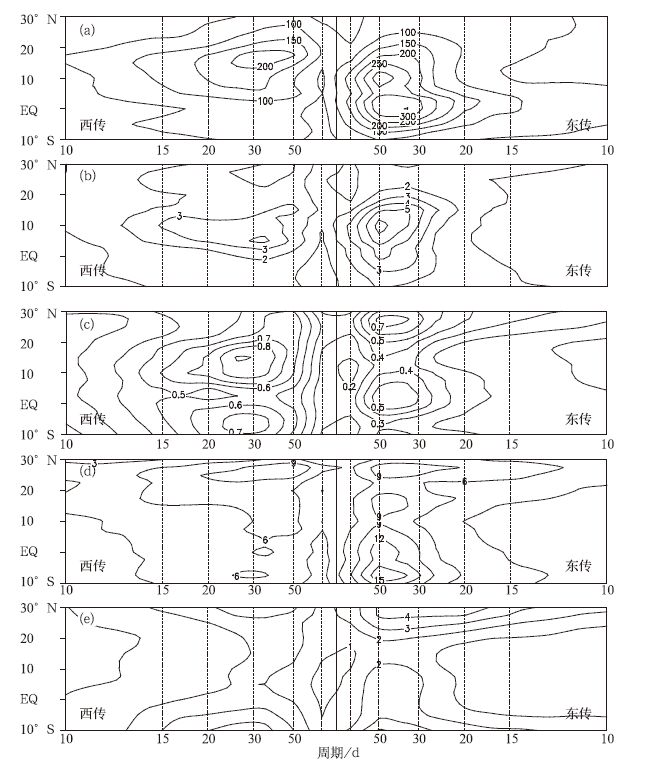
 下载:
下载:
